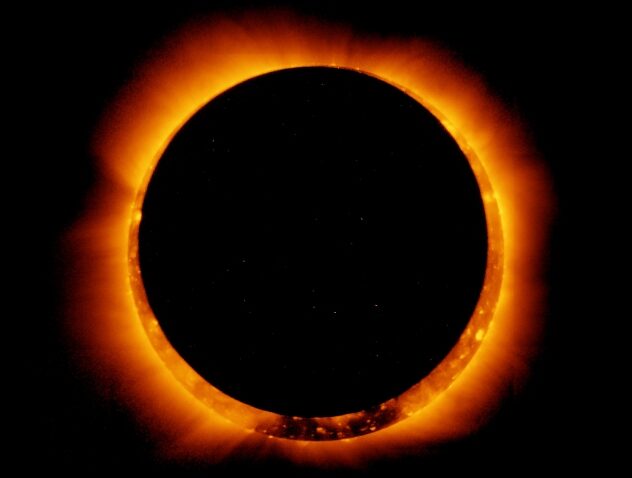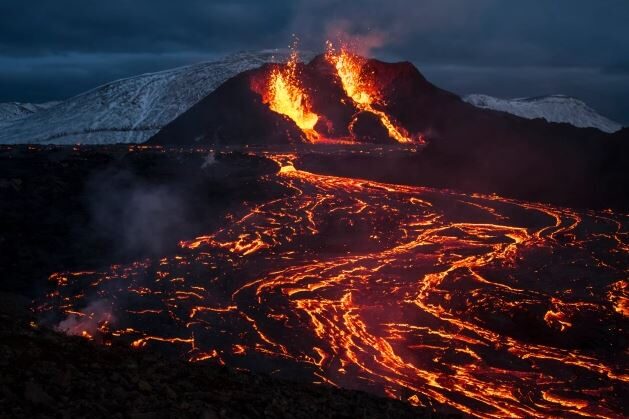
Just 18 months prior, you were a hard-working farmer gearing up for another bountiful crop season.
But then the skies went dark.
From early 536 to 537, they stayed dark. Across much of eastern Europe and throughout Asia, spring turned into summer and fall gave way to winter without a day of sunshine. Like a blackout curtain over the sun, millions of people across the world's most populated countries squinted through dim conditions, breathing in chokingly thick air and losing nearly every crop they were relying on to harvest.
This isn't the plot of a dystopian TV drama or a fantastical "docufiction" production.
This was a harsh reality for the millions of people that lived through that literally dark time or, as some historians have declared, the very worst year ever to be alive.
The darkest year ahead of the darkest decade
"For the sun gave forth its light without brightness, like the moon, during this whole year, and it seemed exceedingly like the sun in eclipse, for the beams it shed were not clear nor such as it is accustomed to shed," was the grim account Procopius, a prominent scholar who became the principal Byzantine historian of the 6th century, gave in History of the Wars. "And from the time when this thing happened men were free neither from war nor pestilence nor any other thing leading to death."
Some 1,500 years later, Harvard University medieval historian Michael McCormick has reached a similarly grim conclusion about not just 536, but the dreadful decade that followed that terrible year. For people living across Europe in 536, "It was the beginning of one of the worst periods to be alive, if not the worst year," McCormick recently said.
As McCormick told AccuWeather, it was all set off by rapid, drastic climate change. In the spring of 536, a volcanic eruption triggered the Late Antique Little Ice Age (LALIA), McCormick told AccuWeather. And its ramifications, on top of ensuing eruptions in 540 and 547, were devastating.
Comment: Space weather, in the form of close encounters (and/or overhead airbursts) with comets or cometary fragments, likely set off those volcanic eruptions - and much more besides. Rome itself, for example, was buried under 9 meters of mud, most likely dumped on it by a tsunami.
"Aerosols for the big volcanic eruptions blocked solar radiation, dropping the solar heating of the Earth's surface," he told AccuWeather in an email, adding that climate analysis from Cambridge University in the U.K. done on tree rings show the average summer temperature "dropped by between 1.5 degrees and 2.5 degrees Celsius across Eurasia."
That's up to 2.7 to 4.5 degrees Fahrenheit cooler due to the heavy smog left behind after the eruption. The skies remained dimmed for up to 18 months, multiple historical witnesses recounted, triggering the dark year of turmoil that earned 536 its dubious distinction.

In the Middle East, China and Europe, a dense fog was an inescapable daily nightmare while widespread agricultural challenges in Ireland resulted in a "failure of bread from the years 536-539 AD," according to The Gaelic Irish Annals.
Comment: Ireland fared better than the rest of western Europe, which was apparently subject to a 'direct hit'. That's why the Roman empire apparently bifurcated into east and west; the 'west' was essentially ablated (wiped off the map) overnight. Ireland avoided the worst of this, which is why its monks - together with the Moors via Spain - 're-seeded civilization' in western Europe when the dust settled.
Much of scientists' understanding of the impacts from the Iceland volcano were found during the Historical Ice Core Project, a partnership between the University of Maine and Harvard University that McCormick co-led along with Professor Paul Mayewski of the Climate Change Institute. Using ice core samples from Iceland, the team mapped out an archeological timeline to pinpoint when and where the initial volcanic eruption must have occurred in Iceland.
Its impacts were widespread and deadly.
"Ancient eyewitnesses report that the sun stopped shining brightly for 14-18 months," McCormick said. "The result was several years of failed harvests, famines, causing migrations and turbulence across Eurasia."

While the 6th century outbreak of the bubonic plague may be less remembered than the 14th-century reoccurrence of the disease (which came to be known as the Black Death), the 6th-century pandemic was still responsible for destroying at least one-third of the eastern Roman Empire population, leading to its collapse.
Comment: Again, that part of the world fared better than western Europe. The eastern 'half' survived to become Byzantium. The western half was essentially left depopulated for several centuries.
Dubbed the Justinian Pandemic or the Plague of Justinian, the disease spread throughout Roman Egypt before infecting the rest of the world over the ensuing 200 years. McCormick said ancient DNA has shown the disease-causing pathogen to be Yersinia pestis, bubonic plague, a disease of rats and other rodents that spilled over into human populations.
In the wake of the climate-altering volcanic eruptions and darkened year of 536, McCormick said the situation was fatally ripe for the plague to wreak havoc.
Although he said there has yet to be a precise relation established between the abrupt onset of the LALIA and the Justinian Pandemic, McCormick said that "it seems likely that, for instance, the food shortages caused by the sudden cooling in many parts of Eurasia weakened the populations and made them more susceptible to the pathogen." The famines almost certainly led to mass migrations of people as well, he said, likely carrying the disease with them.
Comment: Socio-economic factors do provide the fertile ground for cyclical catastrophes, but the common thread between sudden-onset cooling and the recurrence of plague is COMETS, not 'volcanic eruptions' - which, as we see ourselves in our time, are just one symptom of climate change.
Compared to the modern-day hardships dealt by COVID-19, the differences are shocking.
"You have to take the period as a whole," he said, adding that "536 was just the beginning of a very tough time. The plague pandemic on top of the abrupt cooling must have been very difficult. Today COVID-19 is terrible, but compare the death rate for bubonic plague," he continued, pointing to the 1.8% case-fatality ratio in the U.S. compared to the 40% to 60% mortality rate for untreated bubonic plague.
Comment: Covid-19 does not have a 1.8% case-fatality ratio; it has at worst a 0.018% case-fatality ratio. The Black Death (at both the end of the Roman/Antiquity era and at the end of the Medieval era) had a case-fatality ratio of up to 90% in some cities.
So just how massive must those volcanic eruptions have been?
Multiple history-altering eruptions captured in ice
Mayewski, a glaciologist from the University of Maine, was also heavily involved in the Historical Ice Core Project and he told Science Mag that his team was able to analyze 2,000 years worth of historic, natural disasters taken from a 72-meter drilling in Iceland that presented the researchers with a historical timeline of element levels.
Using a laser to carve 120-micron slivers of ice from the core, scientists could analyze the element spikes and drops of different moments in history to line them up with disasters that helped better piece together our understanding of what shaped the world we live in today.
In the ice sample from the spring of 536, graduate student Laura Hartman and volcanologist Andrei Kurbatov found microscopic particles of volcanic glass, which closely matched glass particles previously found in lakes around Europe and an ice core sample taken from Greenland.
Kurbatov concluded that the perfectly disastrous mix of winds and weather in 536 must have guided the plume across Europe and into Asia, casting a chilly pall as the volcanic fog "rolled through."
Other researchers also believe that the Icelandic 536 eruption emitted thick ash that spread across the Northern Hemisphere, pumping large quantities of sulfate into the atmosphere, according to a 2015 article in Smithsonian Magazine.
On top of that eruption, other studies conducted recently have suggested that there could have been more than one volcano responsible for that time period's tragedies.
The other notable blast, researchers says, is believed to have been one of the strongest eruptions of the last 10,000 years, likely only comparable to the 1815 eruption of Mount Tambora.
That Mount Tambora eruption also led to a similarly bleak year, as much of 1816 was also shrouded in darkness, leading to unprecedented low temperatures and hundreds of thousands of deaths from the eruption and starvation due to that season's failed crops. That time period became known as "The Year Without a Summer." In the United States, snow fell in June in New York and Maine while heavy frosts and ice storms occurred as late as July in the region.
In the 6th century, the other history-altering volcano erupted about 5,000 miles away from Iceland in Central America, with a volcanic blast more than a hundred times stronger than the 1980 eruption of Mount St. Helens, Researcher Robert Dull told National Geographic.
A team of researchers published a study in the Quaternary Science Reviews placing the location of the eruption in central El Salvador from the dormant Ilopango. Today, a lake the size of 28 square miles sits in the volcanic caldera left behind.
"This is the largest eruption in Central America that human beings have ever witnessed," Dull, a geologist at California Lutheran University, told the publication. "The importance of the event is even greater, both how the Maya overcame it and how it impacted what happened next."
The pair of cataclysmic eruptions are believed to have combined to trigger the following decade's years of disease, famine and tragedy.
Comment: They're reaching for something - anything! - that will enable them to not mention comets (whose by-products are a far better match than volcanoes for what they're finding in ice core samples)...
The dust veil
Using historical dating techniques such as tree ring analysis and stable carbon isotope records, the researchers presented a model to depict just how brutal life was for people alive at that time.
The dust veil, they say, reduced normal levels of solar radiation and thus ruined years of crop harvests, and "contributed to remarkably simultaneous outbreaks of famine," leaving humans with a long-term lack of vitamin D, which diminished health and quality of life in those years of darkness.
McCormick said that as more natural climate records and LALIA reconstructions are better understood, scientists will be able to be better understand how that dust veil drastically changed the weather in different parts of the Northern Hemisphere.
"The Arabian peninsula for instance, might have become a little less dry, while the effect seems more dramatic and negative north of the Mediterranean," he said. "So far, most of the natural climate records from which the LALIA has been reconstructed come from Eurasia and North America, so more northerly latitudes."
Even if it may sound hard to believe given the past 100 years of multiple World Wars and numerous, devastating pandemics, McCormick told History.com that the horrifying period of history was not blown out of proportion by witness accounts.
Comment: Actually, the last 100 years has been the most disease-free century in human history.
"It was a pretty drastic change; it happened overnight," he said. "The ancient witnesses really were onto something. They were not being hysterical or imagining the end of the world."



I believe the author meant western Roman Empire. The eastern empire collapsed in 1453.